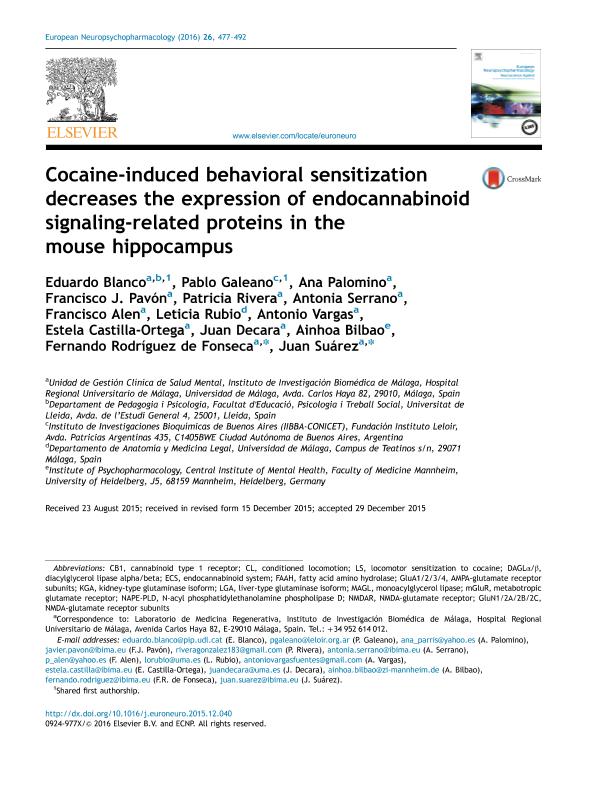Mostrar el registro sencillo del ítem
dc.contributor.author
Blanco, Eduardo
dc.contributor.author
Galeano, Pablo

dc.contributor.author
Palomino, Ana
dc.contributor.author
Pavon, Francisco J.
dc.contributor.author
Rivera, Patricia
dc.contributor.author
Serrano, Antonia
dc.contributor.author
Alen, Francisco
dc.contributor.author
Rubio, Leticia
dc.contributor.author
Vargas, Antonio
dc.contributor.author
Castilla-Ortega, Estela
dc.contributor.author
Decara, Juan
dc.contributor.author
Bilbao, Ainhoa
dc.contributor.author
Rodríguez de Fonseca, Fernando
dc.contributor.author
Suaréz, Juan
dc.date.available
2017-07-18T21:00:43Z
dc.date.issued
2016-03
dc.identifier.citation
Blanco, Eduardo; Galeano, Pablo; Palomino, Ana; Pavon, Francisco J.; Rivera, Patricia; et al.; Cocaine-induced behavioral sensitization decreases the expression of endocannabinoid signaling-related proteins in the mouse hippocampus; Elsevier Inc; European Neuropsychofarmacology; 26; 3; 3-2016; 477-492
dc.identifier.issn
0924-977X
dc.identifier.uri
http://hdl.handle.net/11336/20867
dc.description.abstract
In the reward mesocorticolimbic circuits, the glutamatergic and endocannabinoid systems are implicated in neurobiological mechanisms underlying cocaine addiction. However, the involvement of both systems in the hippocampus, a critical region to process relational information relevant for encoding drug-associated memories, in cocaine-related behaviors remains unknown. In the present work, we studied whether the hippocampal gene/protein expression of relevant glutamate signaling components, including glutamate-synthesizing enzymes and metabotropic and ionotropic receptors, and the hippocampal gene/protein expression of cannabinoid type 1 (CB1) receptor and endocannabinoid metabolic enzymes were altered following acute and/or repeated cocaine administration resulting in conditioned locomotion and locomotor sensitization. Results showed that acute cocaine administration induced an overall down-regulation of glutamate-related gene expression and, specifically, a low phosphorylation level of GluA1. In contrast, locomotor sensitization to cocaine produced an up-regulation of several glutamate receptor-related genes and, specifically, an increased protein expression of the GluN1 receptor subunit. Regarding the endocannabinoid system, acute and repeated cocaine administration were associated with an increased gene/protein expression of CB1 receptors and a decreased gene/protein expression of the endocannabinoid-synthesis enzymes N-acyl phosphatidylethanolamine D (NAPE-PLD) and diacylglycerol lipase alpha (DAGLα). These changes resulted in an overall decrease in endocannabinoid synthesis/degradation ratios, especially NAPE-PLD/fatty acid amide hydrolase and DAGLα/monoacylglycerol lipase, suggesting a reduced endocannabinoid production associated with a compensatory up-regulation of CB1 receptor. Overall, these findings suggest that repeated cocaine administration resulting in locomotor sensitization induces a down-regulation of the endocannabinoid signaling that could contribute to the specifically increased GluN1 expression observed in the hippocampus of cocaine-sensitized mice.
dc.format
application/pdf
dc.language.iso
eng
dc.publisher
Elsevier Inc

dc.rights
info:eu-repo/semantics/openAccess
dc.rights.uri
https://creativecommons.org/licenses/by-nc-sa/2.5/ar/
dc.subject
Cocaine
dc.subject
Conditioned Locomotion
dc.subject
Cocaine Sensitization
dc.subject
Cannabinoid
dc.subject
Glutamate
dc.subject
Hippocampus
dc.subject.classification
Neurociencias

dc.subject.classification
Medicina Básica

dc.subject.classification
CIENCIAS MÉDICAS Y DE LA SALUD

dc.title
Cocaine-induced behavioral sensitization decreases the expression of endocannabinoid signaling-related proteins in the mouse hippocampus
dc.type
info:eu-repo/semantics/article
dc.type
info:ar-repo/semantics/artículo
dc.type
info:eu-repo/semantics/publishedVersion
dc.date.updated
2017-06-12T21:00:21Z
dc.identifier.eissn
1873-7862
dc.journal.volume
26
dc.journal.number
3
dc.journal.pagination
477-492
dc.journal.pais
Países Bajos

dc.journal.ciudad
Amsterdam
dc.description.fil
Fil: Blanco, Eduardo. Universidad de Málaga; España. Universidad de Lleida; España
dc.description.fil
Fil: Galeano, Pablo. Consejo Nacional de Investigaciones Científicas y Técnicas. Oficina de Coordinación Administrativa Parque Centenario. Instituto de Investigaciones Bioquímicas de Buenos Aires. Fundación Instituto Leloir. Instituto de Investigaciones Bioquímicas de Buenos Aires; Argentina
dc.description.fil
Fil: Palomino, Ana. Universidad de Málaga; España
dc.description.fil
Fil: Pavon, Francisco J.. Universidad de Málaga; España
dc.description.fil
Fil: Rivera, Patricia. Universidad de Málaga; España
dc.description.fil
Fil: Serrano, Antonia. Universidad de Málaga; España
dc.description.fil
Fil: Alen, Francisco. Universidad de Málaga; España
dc.description.fil
Fil: Rubio, Leticia. Universidad de Málaga; España
dc.description.fil
Fil: Vargas, Antonio. Universidad de Málaga; España
dc.description.fil
Fil: Castilla-Ortega, Estela. Universidad de Málaga; España
dc.description.fil
Fil: Decara, Juan. Universidad de Málaga; España
dc.description.fil
Fil: Bilbao, Ainhoa. Universidad de Málaga; España
dc.description.fil
Fil: Rodríguez de Fonseca, Fernando. Universidad de Málaga; España
dc.description.fil
Fil: Suaréz, Juan. Universidad de Málaga; España
dc.journal.title
European Neuropsychofarmacology

dc.relation.alternativeid
info:eu-repo/semantics/altIdentifier/url/http://www.sciencedirect.com/science/article/pii/S0924977X15004307
dc.relation.alternativeid
info:eu-repo/semantics/altIdentifier/doi/https://doi.org/10.1016/j.euroneuro.2015.12.040
Archivos asociados
